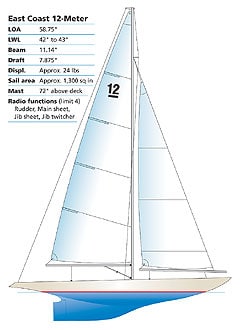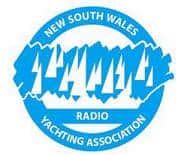The Early Years
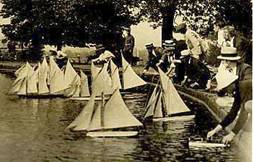
Early Model Yachts starting a race in a small pond, Photo Stephen Crewes.
The building and racing of scaled down racing yachts is not a recent idea, but has a long and rich history worldwide. With records showing such yachts being sailed in organised groups in England as far back as the early 1800’s. The earliest recorded history of model yachts in Sydney is in 1868 when an English Naval Squadron visiting Sydney, report the event of Model Yacht Racing in the park land around the city. There were several early clubs racing on the harbour and at various lakes such as the one in Centennial Park. These early yachts were controlled by setting the sails for tacking, reaching or running and fixing the rudder. The boat would then have to be followed for the length of its course to the other side of a lake, its rig would then be re-adjusted and the yacht would be sent on its next course.
The late 1800’s and early 1900’s saw model yacht racing skippers and a crewman (usually out of season footballers looking for some exercise), racing their boats around large courses on Sydney Harbour. These boats were very similar to the types of Skiffs being raced in Sydney at the time, short skiff type hulls with heavily over canvassed rigs. The crew would row along behind their charges grabbing them at the next mark, resetting the rig and fin and then set them loose on the next leg of their race. This form of Model Yacht Racing became very popular, especially during the depression were skippers and crew could earn themselves some extra money for a win or a place or for taking a bookies sponsored dive to loose the race on purpose! Large amounts of money would change hands out on the water as ferries crammed full of punters would follow the fleet around the harbour.
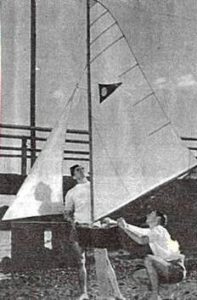
Skipper and crew attending to a Model Skiff, circa 1930’s. Photo Stephen Crewes
Yachts automatically steered (kept on course) by Vane Gear mounted on the rudder became popular around the mid 1930’s. If the boats course was altered in any way the vane would move the rudder slightly to bring it back on course, but these boats were still only capable of sailing on a course between two fixed points. With the introduction of Radio Control equipment in the early 1970’s all this changed. For the first time the skippers had some control of their yachts not only being able to steer the boat by operating the rudder but also being able to control the sails using small electric servo motors inside the boat.
Radio Controlled Yacht Racing Today
Today’s modern Radio Controlled (RC) Yachts bear only a passing resemblance to their heavy, wooden hulled over canvassed forebears from the past and look more like their full sized ocean racing cousins. Many RC Yachts were, and still are designed and built by reputable yacht designers to test out their theories prior to full size production. With today’s hulls manufactured from modern materials such as glass fibre, carbon fibre and epoxy resins as well as sails made from mylar film the current styles of RC racing yachts are durable, fast and reliable.
Standard International Sailing Federation (ISAF) Racing Rules as modified by Appendix E apply to RC Yacht Racing. All the preparation, skill and tactics of modern yacht racing are available in RC Yacht Racing. The sport of RC Yacht Racing appeals to a wide range of different tastes, you might be looking for some close competition racing during the winter season or you might be interested in designing, building and racing your own yacht. Many skippers in the various clubs have become involved in RC Yacht Racing after having sailed full sized yachts or dinghies so there is already a lot of talent in the various classes. Having said this One Design Entry Level Yachts also cater for the novice who has never sailed before and gives them the ability to get involved on a “level playing field”. Age, gender or physical condition usually provides no barrier when wanting to get involved in the sport of RC Yacht Racing. There are quite a few clubs in NSW, some based at local full size yacht clubs and others operating from lakes and rivers.
Current RC Yacht Classes
There are six main classes of RC Yacht currently available in NSW, most of which can be raced at club, interclub, state, national and international regattas. These classes are the International One Meter Class, Marblehead Class, 10 Rater Class, A Class, East Coast 12 and Soling One Meter Class. These classes offer something for everyone ranging from One Design, cheap on water action through to boats such as the high performance 10 Rater Class or the large majestic A Class. Each class has its own set of class rules that governs it for such things as minimum sailing weights, hull lengths, size of sails, depth of fin and types of materials used.
One Metre
The One Metre class is the fastest growing international class of RC. The class rules are very tight and limit yachts to two-channel control, and three one design rigs. Hull, ballast, draught and construction materials are also limited. There is, however, sufficient freedom to allow different hull, fin and rudder shapes to be developed.
The One Metre is sailed in all states. The tight rules have the effect of allowing beginners to produce a competitive yacht while keeping costs down. Maximum length is 1 Metre. Mast height is 1.7m and Minimum weight is 4kg.
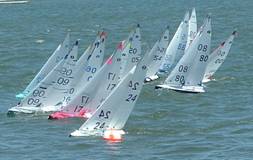
Marblehead
The Marblehead (M) class is popular worldwide and is sailed in all states of Australia. The M class is a restricted development class, and is controlled by a few maximum dimensions. The boat is restricted to a maximum length and sail area. There are no restrictions on beam, weight or construction.
The typical weight for an M is between 4.5 and 5.5 kg. The M class has exciting performance and if properly rigged can handle most sailing conditions.
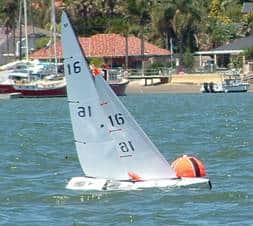
A Class
The A class is the largest and most graceful of the RC yacht classes. The class is based on a similar formula to that used by full size 5.5 Metre yachts.
Length overall can vary between 1.6 and 2.3 Metres, and weigh between 11.3 and 23kgs. Typical weight of a Modern A Class is around 14kg. The A class is popular in many states and is large enough to handle any conditions.
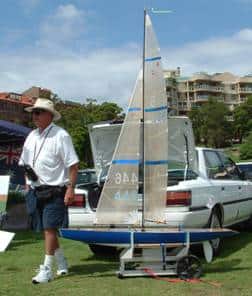
10 Rater
The 10 Rater yacht is generally more graceful than the Marblehead. The freedom to choose water-line length against sail area produces a rather sleek appearance and is the classes’ main attraction. The 10 Rater is a medium sized yacht and is the fastest International class. The 10 Rater class is sailed in all Australian states. The 10 is a development class restricted by a simple formula of waterline multiplied by sail area, multiplied by eight, to equal ten. As there are few restrictions, the class allows the greatest room for development work and experimentation.
Typically the hull is 1.5m long and the all up weight is between 5.5 and 7.5kg. The class has spectacular performance and can handle the worst sailing conditions.
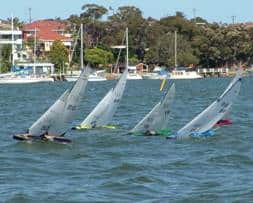
Soling One Meter
The Soling One Meter is the most recent RC Yacht to be sanctioned by the NSW Radio Yachting Association. The Soling One Meter is a kit yacht based on the full-size Olympic Soling. This one design yacht is readily available in kit form only from Hobby Shops.
The class allows few variations from the standard kit and is 1.0 meter long. It is the perfect beginners yacht.
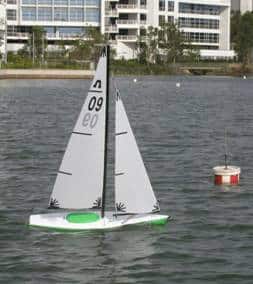
East Coast 12
The East Coast 12 Meter is based on a 1962-63 classic design for a full-size International 12 Meter. This medium-sized yacht's hull must be initially purchased from a licensed builder. Decks and sails are strictly controlled, but may be purchased or made from scratch. Almost all the other equipment is up to the owner.
Approx 1.473 meters long.
